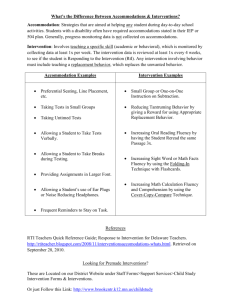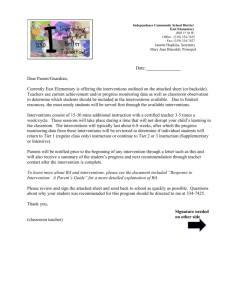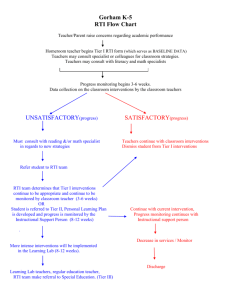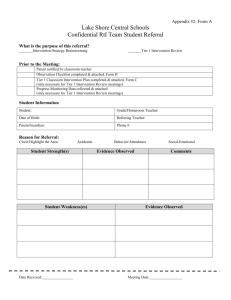Northeast Regional Resource Center
advertisement
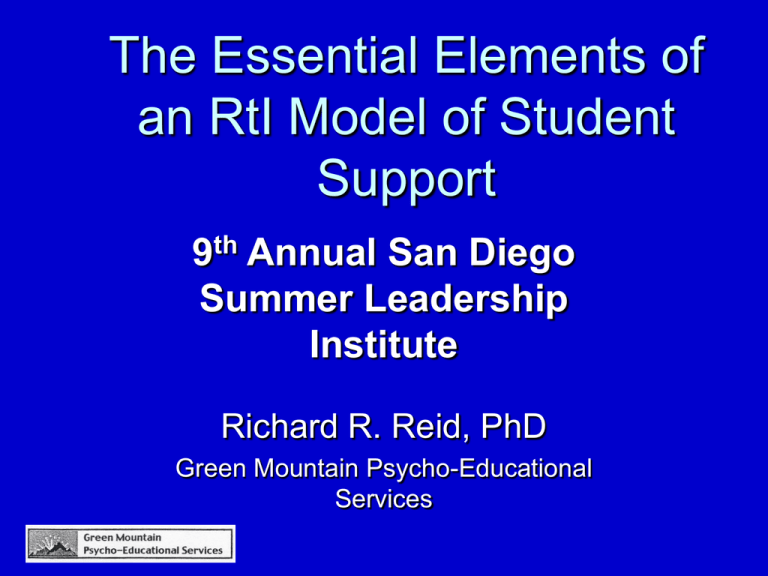
The Essential Elements of an RtI Model of Student Support 9th Annual San Diego Summer Leadership Institute Richard R. Reid, PhD Green Mountain Psycho-Educational Services The following contributed to the content of this presentation. Additional information can be found at their respective websites. National Research Center on Learning Disabilities (NRCLD) Albany Community School Allen Brook School Glover Community School Williston Central School Wolcott Elementary School National Student Progress Monitoring Center Definition RtI is a process for improving the educational outcomes of all students through monitoring student progress and using the data to make decisions about instructional needs and modifications. This process utilizes quick and efficient assessment procedures and is useful in managing early intervening services; and information from this process can be used as part of the process for determination of LD. Responsiveness to Intervention Critical Features & System Components RTI: Practices Critical Feature Students receive high quality, research-based instruction by qualified staff in their general education setting. Research Supported Core Reading Instruction …integrates the features that identify scientifically based reading research Phonemic awareness Phonics Fluency Vocabulary Comprehension Phonemic Awareness Phonemic awareness is the ability to hear, identify, and manipulate individual sounds in spoken words (Torgesen, 1998). PA Research & Instruction PA improves word reading, spelling, and comprehension Poor readers who enter first grade with weak PA are most likely to be the poor readers in fourth grade Auditory Activities Needs to follow the developmental hierarchy of phonological awareness Phonics An understanding of the alphabetic principle—the relationship between phonemes and graphemes. Phonics Research Systematic and explicit phonics instruction… – is more effective than non-systematic or no phonics instruction – significantly improves young children’s decoding, spelling, and reading comprehension and older students’ word reading and oral text reading skills. Fluency The ability to read text –quickly –accurately –with proper expression Fluency Research Repeated and monitored oral reading improves reading fluency and overall reading achievement. Caution: Silent, independent reading with little guidance or feedback may not be enough to improve fluency and overall reading achievement. Vocabulary • The knowledge of the meanings and pronunciation of words that are used in oral and written language. Vocabulary Research Can be developed – Directly (teach important, difficult, and useful words) (Beck et. al, 2002). – Indirectly Vocabulary knowledge is strongly related to overall reading comprehension. The relationship of vocabulary to reading comprehension gets stronger as reading material becomes more complex and the vocabulary becomes more extensive. Comprehension The ability to make sense of text and to monitor for understanding. Comprehension Research Text comprehension can be improved by instruction that – is explicit and direct – helps readers use specific comprehension strategies Differentiation of Instruction A teaching philosophy based on the premise that teachers should adapt instruction to student differences Teachers modify their instruction to meet students varying readiness levels, learning preferences, and interests Is It Worth It? There is no bigger challenge than inserting students into a one size fits all classroom and then dealing with the spillover of the emotional and behavioral reactions Research Supported Core Math Instruction …integrates the features that identify scientifically based reading research Understanding Computing Applying Reasoning Engaging RTI: Practices Critical Features General education instructors and staff assume an active role in students’ assessment in that curriculum by conducting universal screening of academics. Universal Screening Results in Early Intervention Early Intervention Makes a Difference Can significantly reduce number of children performing below criterion Results tend to be long lasting for most children Largest gains are observed during early intervention Puts children on growth trajectory Provides a basis for progress monitoring (benchmarking for all, frequent monitoring for at risk students) Early Intervention Makes a Difference Can significantly reduce number of children performing below criterion Tier 1 interventions can result in reducing at risk readers from 20% of population to 6% Tier 2 interventions can further reduce to 2 to 4% Results tend to be long lasting for most children Largest gains are observed during early intervention Puts children on growth trajectory Universal Screening Students are tested at one point in time. Those scoring below a score are designated at risk. It results in instructional decision making At-risk students may enter preventative intervention. What to Screen? Skills needs to be a reliable predictors of future performance Tools need to be: Readily available Standardized Easily administered/efficient Psychometric properties available? Sensitivity and Specificity Reliability Predictive validity Some Skills to Screen Phonological Awareness – Phoneme segmentation fluency Rapid Automatic Naming – Letter Naming – Letter Sound Phonics – Nonsense word Fluency Word Identification Oral Reading Fluency Reading Comprehension Vocabulary Quantity array Number identification Quantity discrimination Missing number Curriculum Based Measurement CBM Curriculum Based Assessment vs. Curriculum Based Measurement CBA is a very broad term that describes any testing strategy that uses a students curriculum as the basis for assessment and decision making. CBM is one type of CBA …connects oral words and numerals Up to 50 Demonstrates an Understanding of the Relative magnitude Of numbers …understands additio and subtraction by solving problems Involving situations in which one adds to, takes from Recognizes and Names coins Estimates and evaluates reasonableness of solutions Reading Fluency Key Features of CBM Tests sample year-long curriculum Tests are relatively brief and easy to administer Tests are given frequently (e.g., from twice weekly to every month) to judge student progress Each alternate form samples the same types of skills at the same level of difficulty Key Features of CBM Student performance is used to set longterm goals Scores are graphed, and teachers use a decision-making framework to judge adequacy of student progress Data are used to compare/contrast effectiveness of different instructional methods CBM has documented reliability and validity CBM’s are General Outcome Measures Designed to serve as “signs” of general achievement CBM’s are General Outcome Measures Designed to serve as “signs” of general achievement Are typically fluency measures Fluency What is it? – The ability to quickly and accurately apply or engage in a basic skill – Automaticity provides an overall indicator of student growth and development in the skill area. What is it not? – Fluency will not tell you everything you need to know about student performance. – However, there is a strong relationship between fluency and the comprehensive application of the basic skill. CBM’s are General Outcome Measures Designed to serve as “signs” of general achievement Are typically fluency measures Are standardized tests CBM’s are General Outcome Measures Designed to serve as “signs” of general achievement Are typically fluency measures Are standardized tests Are designed to be as short as possible so as not to conflict with teaching. CBM’s are General Outcome Measures Designed to serve as “signs” of general achievement Are typically fluency measures Are standardized tests Are designed to be as short as possible so as not to conflict with teaching. Describe academic competence at a single point in time CBM’s are General Outcome Measures Are sensitive to improvement in short periods of time so you can quantify the rate at which students develop academic competence over time CBM’s are General Outcome Measures Are sensitive to improvement in short periods of time so quantify the rate at which students develop academic competence over time Each CBM test is of equivalent difficulty CBM’s are General Outcome Measures Are sensitive to improvement in short periods of time so quantify the rate at which students develop academic competence over time Each CBM test is of equivalent difficulty Measurement is frequent CBM’s are General Outcome Measures Assessment information is used to formulate instructional decisions to build more effective programs to increase student achievement CBM’s are General Outcome Measures Assessment information is used to formulate instructional decisions to build more effective programs to increase student achievement Have capacity for providing growth trajectory (samples year long) Reading Fluency Norms Grade VT GEs AIMSweb Hasbrouck & Tindal (2005) 1 50-80 59 (90K) 53 (20K) 2 80-100 95 (85K) 89 (20K) 3 90-120 111(85K) 107 (18K) 4 115-140 128 (60K) 123 (16K) 5 125-150 140 (57K) 139 (15K) 6 135-160 154 (35K) 150 (11K) 7 140-175 154 (24K) 150 (6K) 8 150-180 153 (20K) 151 (5K) Reading Fluency 120 Words Correct Per Minute 110 100 90 80 70 60 50 1 2 3 4 5 6 Beenchmark Probes 7 8 9 10 RTI: Practices Critical Feature Frequent progress monitoring of student performance occurs for all students and is used to pinpoint student-specific difficulties. Progress Monitoring Schedule Reading Fluency 120 Words Correct Per Minute 110 100 90 80 70 60 50 1 2 3 4 5 6 Beenchmark Probes Parent Contact Fall of 3rd grade 7 8 9 10 Progress Monitoring Teachers assess students’ academic performance on a regular basis to: – determine whether children are profiting appropriately from instruction & interventions – build more effective programs for children who do not benefit appropriately from typical instruction – provide students with feedback and enhance motivation and encouraging goal-directed behavior Formative Evaluation Ongoing, systematic monitoring of student performance occurs with individuals in: – the general education classroom – during supplemental instruction – during intensive instruction Formative Evaluation Is ongoing evaluation of student progress toward meeting goals, standards, GLEs It examines learning as skills are being taught It requires frequent and direct data collection. If data is collected daily, decisions can be made daily Why Is Progress Monitoring Important? Research has demonstrated that when teachers use progress monitoring for instructional decision-making purposes: – students achieve at higher levels – teacher decision-making improves – students tend to be more aware of their performance (e.g., see Fuchs, Deno, Mirkin, 1984; L. S. Fuchs, Fuchs, Hamlett, & Ferguson, 1992; Stecker, Fuchs, & Fuchs, in press) Benefits of Conducting Progress Monitoring Student performance data on important, gradelevel skills/content can be gathered quickly and easily Student progress can be analyzed in order to modify instructional programs when needed and/or adjust student goals upward Individual student data can be compared to data of other students in the classroom, in the child’s school, or in the school district Degrees of Progress Monitoring Benchmarking/School Wide Screening Assess all children three to four times over the course of the school year Strategic Monitoring Assess children in “some risk” category every two-four weeks Intensive Monitoring Assess children in “at risk” category as often as weekly Questions Students Ask Themselves about CBM Graphs Are my scores going up? What’s my highest score? Can I beat it in the next 2 weeks? What skill(s) do I want to work hard on during the next 2 weeks to try to increase my CBM score? RTI: Practices Critical Feature School staff implement scientific, researchbased interventions to address a student’s difficulties. Rationale for Research-Based Interventions Interventions that have a proven track record increase the probability of success for our students Interventions based on theory, professional opinion, testimonial, and subjective evaluation rarely stand up to closer scrutiny Implementation of ineffective interventions delays implementation of effective interventions RTI: Practices Critical Feature School staff use progress-monitoring data and decision rules to determine intervention’s effectiveness and needed modifications. Decision Making Through an Examination of the Data What Are the Decisions that Teachers Need to Make? Estimate rates improvement Identify students who are not demonstrating adequate progress Measure students response to the intervention Compare the efficacy of different forms of instruction to design more effective, individualized instructional programs for struggling learners Data-based Decision Making Rather than making decisions that are based on indirect and inferential test measures, decisions are based on hard data in regard to the student’s response to instruction and/or intervention. A priori decision making rules are adopted. Graphs are essential in Facilitating the decision making process!!! General Decision-Making Framework Trend-Line Rule – If trend of student progress is steeper than goal line, raise goal. – If trend of student progress is less steep than goal line, make a teaching change. – Requires a minimum of 3 data points (3 weeks of instruction) Goal or Aim Line Trend Line Goal or Aim Line Trend Line Goal or Aim Line Trend Line Goal or Aim Line Trend Line General Decision-Making Framework 4-Point Rule – – – – At least four weeks of instruction have occurred. If all 4 are above goal line, increase goal. If all 4 are below goal line, make a teaching change. If the 4 data points are both above and below the goal line, keep collecting data until trend-line rule or 4-point rule can be applied. Goal or Aim Line RTI: Practices Critical Feature Systematic assessment of the fidelity and integrity with which instruction and interventions is conducted. Fidelity = the teacher uses all of the intervention components skillfully Integrity = the teacher adheres to the recommended procedures and practices. Fidelity matters across evidencebased programs The best outcomes are associated with high fidelity practitioners Careful attention to the implementation of evidence-based programs results in high fidelity Evidence of the effectiveness of an intervention does not help implement the program or practice successfully RTI: Practices Critical Feature No. 7 Support services are provided in multiple tiers of increasingly intense student interventions. School-Wide Systems for Student Success Behavioral Systems Academic Systems Intensive, Individual Interventions •Individual Students •Data-based •High Intensity •Of longer duration 1-5% 5-10% Targeted Small Group Interventions •Fixed Duration/Intensive •Supplemental Services •Standard Protocol Approach •Data-based Universal Interventions •All students •Preventive, proactive 80-90% Intensive, Individual Interventions •Individual Students •Assessment-based •Intense, durable procedures 1-5% 5-10% 80-90% Targeted Group Interventions •Some students (at-risk) •High efficiency •Rapid response Universal Interventions •All settings, all students •Preventive, proactive National Reading Panel Conclusions A combination of comprehension strategies is most effective Scientific, Research Based Interventions Explicit, systematic instruction Target areas of need (five components of skilled reading) National Reading Panel Conclusions Provide intense intervention Focus on specific skill development Implemented by trained personnel The Theory Behind Tier I When Tier I instruction is implemented with fidelity, using a well-designed, evidence-based instructional activities, it should meet the needs of 80-90% of our students. The Theory Behind Tier II When Tier I instruction is implemented with fidelity, using a well-designed, evidencebased instructional activities, and struggling students are provided with appropriate and sufficient supplemental supports, it should meet the needs of 90-95% of our students. Tier II (NIHCD Research) Small Groups (1:3, 1:5, 1:10) 10-12 wks, 3-4x per wk, 30-60 min per session Scripted, specific intervention Point system for motivation Immediate corrective feedback Mastery of content before moving on More time on difficult activities More opportunities to respond Fewer transitions Setting goals and self monitoring Rapid Responders to Tier II Those without underlying processing disorders (e.g., naming speed) Those with phonemic awareness difficulties Those whose reading problems are a result of limited exposure Those with better foundational literacy skills IQ does not differentiate those who will respond The Theory Behind Tier III In spite of our best efforts to support students, there will be 5-10% of our students, who as a result of a learning disability, will continue to require intensive services for a prolonged period pf time. Billy's Reading Fluency Progress 110 Differentiated Instruction – Paired Reading Correct Words Per Minute 100 90 80 Tier 1 70 60 50 40 30 20 1 2 3 4 5 6 Fluency Probes 7 8 9 10 Billy's Reading Fluency Progress 110 Differentiated Instruction – Paired Reading Correct Words Per Minute 100 90 80 Tier 1 70 60 50 40 30 20 1 2 3 4 5 6 Fluency Probes 7 8 9 10 Billy's Reading Fluency Progress 110 Differentiated Instruction – Paired Reading Correct Words Per Minute 100 90 80 Great Leaps Reading Tier 2 Tier 1 70 60 50 40 30 20 1 2 3 4 5 6 Fluency Probes 7 8 9 10 Billy's Reading Fluency Progress 110 90 Differentiated Instruction – Paired Reading 80 Tier 1 Correct Words Per Minute 100 Great Leaps Reading Read Naturally & Speed Drills Tier 2 Tier 3 70 60 50 40 30 20 1 2 3 4 5 6 Fluency Probes 7 8 9 10 RTI: Practices Critical Feature The Educational Support Team is staffed by key personnel and utilizes an efficient targeted intervention & problem solving model to address student needs. Your School’s EST The Backbone of RtI Does your educational support team function in a way that can support a response to intervention model? Problem Solving Models Standard Protocol and Problem Solving Models Standard Protocol Approach Standard Protocols/Targeted Interventions as part of the problem solving process – Very specific curricular and instructional approaches – Have a history or research base in efficacy – Facilities efficiency Problem Solving Approach 1) 2) 3) 4) Problem statement Hypothesis generation Hypothesis testing Checking Goals and Roles of the EST a.k.a. SST Creates an environment for teachers, parents, and other professionals to collaborate and problem solve together Works to support teachers by making data-based recommendations Is a venue for administrative leadership Willingness to improve or expand its practices Goals and Roles of the EST Work efficiently, become more focused Develop a community that will help solve academic problems Help classroom teachers make databased decisions Increase exposure to research-based interventions, what is working and what is not Goals and Roles of the EST Create an inventory of effective interventions, strategies, and supports Monitor the overall academic health of the school Make recommendations for systems change as necessary Engage in a systematic, effective, and efficient problem solving Goals and Roles of the EST Guarantees high quality classroom instruction On going monitoring of student progress Interventions are designed collaboratively by teacher teams which includes general educators, reading specialists, school counselors, school psychologist, behavior specialist, special educators, and parents Goals and Roles of the EST Plans interventions so students may meet academic and behavioral benchmarks Designs targeted interventions based on student needs. They can take place during whole class, small group or individual instruction, as well as in the community Encourages parental participation throughout the process Therefore…Parental Involvement Supports RtI Parents have vast knowledge about their children and must be partners in the educational system in sharing information Teachers and parents in partnership use the resources necessary to meet the educational needs of children in order to promote positive outcomes Accurate information about student progress is communicated regularly between the school and the family
